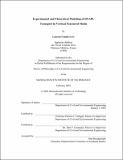| dc.contributor.advisor | Patricia J. Culligan and John T. Germaine. | en_US |
| dc.contributor.author | Levy, Laurent Claude, 1973- | en_US |
| dc.contributor.other | Massachusetts Institute of Technology. Dept. of Civil and Environmental Engineering. | en_US |
| dc.date.accessioned | 2005-05-19T15:13:38Z | |
| dc.date.available | 2005-05-19T15:13:38Z | |
| dc.date.copyright | 2003 | en_US |
| dc.date.issued | 2003 | en_US |
| dc.identifier.uri | http://hdl.handle.net/1721.1/16903 | |
| dc.description | Thesis (Ph. D .)--Massachusetts Institute of Technology, Dept. of Civil and Environmental Engineering, 2003. | en_US |
| dc.description | Vita. | en_US |
| dc.description | Includes bibliographical references. | en_US |
| dc.description | This electronic version was submitted by the student author. The certified thesis is available in the Institute Archives and Special Collections. | en_US |
| dc.description.abstract | In recent years, groundwater contamination by dense, non-aqueous phase liquids (DNAPLs) such as chlorinated solvents and polychlorinated biphenyls (PCBs) has become an important environmental concern in many industrialized areas. Accidental spills, poor storage facilities and inadequate disposal practices are factors contributing to the release of these chemicals into the subsurface environment. The detection and presence of DNAPLs at hazardous waste sites is likely to be a significant limiting factor in the site remediation process. This is especially true for the remediation of complex subsurface formations, such as fractured bedrock. This work has developed a new model describing DNAPL infiltration into a water- saturated, vertical fracture idealized as a circular section capillary tube. A series of laboratory and geotechnical centrifuge experiments of DNAPL infiltration into vertical capillary tubes was performed to demonstrate the validity of the model, and examine the role played by capillary, gravity, viscous, and inertia forces during the infiltration process. The new model can be used to better understand the processes likely to influence DNAPL transport and remediation in real fracture systems. | en_US |
| dc.description.abstract | (cont.) Laboratory infiltration experiments showed that the common assumption of perfect wetting at the DNAPL/water interface is incorrect. Furthermore, it was shown that contact angle hysteresis and interface meniscus pinning influence the DNAPL pool height required to infiltrate a capillary tube and also contribute to its variability. The laboratory experiments also showed that during the infiltration process, the contact angle reduces with velocity leading to an increase in the capillary forces with velocity. A model of the infiltration kinetics incorporating a velocity-dependent dynamic contact angle and pinning effects was successful at predicting the experimental results. Centrifuge infiltration experiments demonstrated the conditions required for the validity of the scaling laws used for centrifuge modeling. The experimental results suggest that the geotechnical centrifuge can be used to examine general DNAPL behavior in simple fracture systems. Nonetheless, the variability of the DNAPL infiltration pool height, the effects of inertia, and the dependence of capillary forces upon velocity are factors that also influence the centrifuge modeling process, and thus need to be accounted for in the interpretation of the centrifuge test data. | en_US |
| dc.description.statementofresponsibility | by Laurent Claude Levy. | en_US |
| dc.format.extent | 2 v. (614 p.) | en_US |
| dc.format.extent | 6654704 bytes | |
| dc.format.extent | 6654459 bytes | |
| dc.format.mimetype | application/pdf | |
| dc.format.mimetype | application/pdf | |
| dc.language.iso | eng | en_US |
| dc.publisher | Massachusetts Institute of Technology | en_US |
| dc.rights | M.I.T. theses are protected by copyright. They may be viewed from this source for any purpose, but reproduction or distribution in any format is prohibited without written permission. See provided URL for inquiries about permission. | en_US |
| dc.rights.uri | http://dspace.mit.edu/handle/1721.1/7582 | |
| dc.subject | Civil and Environmental Engineering. | en_US |
| dc.title | Experimental and theoretical modeling of DNAPL transport in vertical fractured media | en_US |
| dc.title.alternative | Experimental and theoretical modeling of dense, non-aqueous phase liquids transport in vertical fractured media | en_US |
| dc.type | Thesis | en_US |
| dc.description.degree | Ph.D . | en_US |
| dc.contributor.department | Massachusetts Institute of Technology. Department of Civil and Environmental Engineering | |
| dc.identifier.oclc | 52255477 | en_US |
